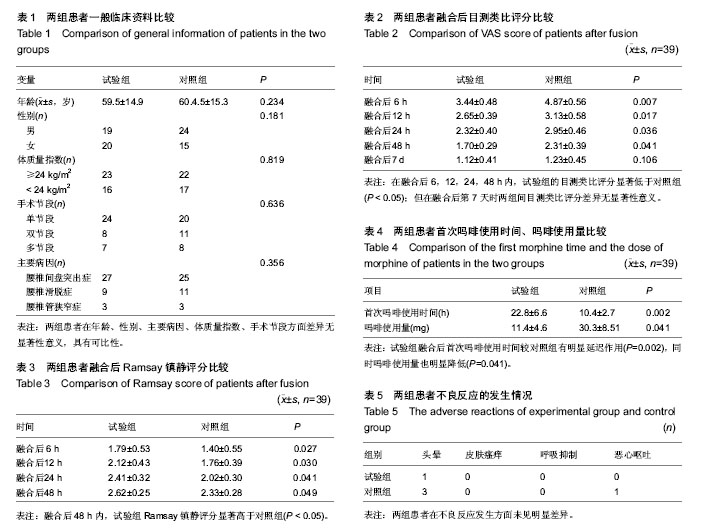| [1] Negrini S. Approach to scoliosis changed due to causes other than evidence: patients call for conservative (rehabilitation) experts to join in team orthopedic surgeons. Disabil Rehabil. 2008;30(10): 731-741.
[2] Lowry KJ, Tobias J, Kittle D, et al. Postoperative pain control using epidural catheters after anterior spinal fusion for adolescent scoliosis. Spine. 2001;26(11): 1290-1293.
[3] Cohen BE, Hartman MB, Wade JT, et al. Postoperative pain control after lumbar spine fusion: patient-controlled analgesia versus continuous epidural analgesia. Spine. 1997;22(16): 1892-1896.
[4] Grant RP, Dolman JF, Harper JA, et al. Patient-controlled lumbar epidural fentanyl compared with patient –controlled intravenous fentanyl for post -thoracotomy pain. Can J Anaesth.1992;39(3): 214-219.
[5] Kehlet H,Dahl JB. The value of“ multimodal” or“ balanced analgesia” in postoperative pain treatment. Anesth Analg. 1993;77(5):1048-1056.
[6] Souter AJ,Fredman B,White PF. Controversies in the perioperative use of nonsterodial antiinflammatory drugs. Anesth Analg. 1994;79(6):1178-1190.
[7] Gottschalk A, Freitag M, Tank S, et al. Quality of postoperative pain using an intraoperatively placed epidural catheter after major lumbar spinal surgery . Anesthesiology. 2004;101(1): 175-180.
[8] Block BM, Liu SS, Rowlingson AJ, et al. Efficacy of postoperative epidural analgesia: a meta-analysis. JAMA. 2003;290(18):2455-2463.
[9] 梁林,姜为民.硬膜外镇痛和静脉镇痛对脊柱融合术后镇痛效果比较的Meta分析[J].中国脊柱脊髓杂志,2014,24(5): 433-439.
[10] Dolin SJ, Cashman JN, Bland JM. Effectiveness of acute postoperative pain management: I. Evidence from published data. Br J Anaesth. 2002;89(3):409-423.
[11] 毛克政,刘建恒,李鹏,等.帕瑞昔布和塞来昔布在脊柱融合术后镇痛效果比较[J].解放军医学院学报, 2013,34(3):237-239.
[12] Al-Sukhun J,Al-Sukhun S,Penttilä H,et al. Preemptive analgesic effect of low doses of celecoxib is superior to low doses of traditional nonsteroidal anti-inflammatory drugs. J Craniofac Surg. 2012;23(2):526-529.
[13] Joshua WB, Mickelson J, Hung M, et al. A randomized prospective evaluation of three techniques of post-operative pain management following posterior spinal instrumentation and fusion. Spine. 2013;38(19):1626-1631.
[14] Gauger VT, Voepel -Lewis TD, Burke CN, et al. Epidural analgesia compared with intravenous analgesia after pediatric posterior spinal fusion. J Pediatr Orthop. 2009;29(6): 588-593.
[15] Stubbs DF. Visual analogue scale. Br J Clin Pharmacol. 1979;7:124.
[16] Ramsay MA,SavegeTM,Simpson BR, et al. Controlled sedation with alphaxalone and alphadolone. Br Med J. 1974; 22(920):656-659.
[17] Blumenthal S, Min K, Nadig M, et al. Double epidural catheter with ropivacaine versus intravenous morphine: a comparison for postoperative analgesia after scoliosis correction surgery. Anesthesiology. 2005;102(1):175-180.
[18] Dolin SJ, Cashman JN, Bland JM. Effectiveness of acute postoperative pain management: I. Evidence from published data. Br J Anaesth. 2002;89(3):409-423.
[19] Yukawa Y, Kato F, Ito K, et al. A prospective randomized study of preemptive analgesia for postoperative pain in the patients undergoing posterior lumbar interbody fusion:continuous subcutaneous morphine, continuous epidural morphine, and diclofenac sodium. Spine. 2005;30(21):2357-2361.
[20] Kehlet H,Dahl JB. The Value of “multimodal”or“balanced analgesia”in postoperative pain treatment.Anaesth Analg. 1993; 77:1048-1056.
[21] Thienthong S,Jirarattanaphochai K,Krisanaprakornkit W,et al.Treatment of pain after spinal surgery in the recovery room by single dose ornoxicam:a randomized,double blind, placebo controlled trial. J Med Assoc Thai. 2004;87(6): 650-655.
[22] 王晓,贾堂红,龚维明,等.复合镇痛方剂用于脊柱后路手术术后镇痛的临床研究[J].中国矫形外科杂志,2013,21(12):1186-1189.
[23] 曾金才,孙俊英,杨立文, 等.关节内置管局部浸润镇痛在全膝关节置换术的应用[J].中国矫形外科杂志, 2009,17(21):1609-1612.
[24] Parvataneni HK,Shah VP,Howard H, et al.Controlling pain after total hip and knee arthroplasty using a multimodal protocol with local periarticular injections: a prospective randomized study. J Arthroplasty. 2007;6:33-38.
[25] Ekman EF,Wahba M,Ancona F.Analgesic efficacy of perioperative celecoxib in ambulatory arthroscopic knee surgery: a double- blind,placebo- controlled study. Arthroscopy. 2006;22(6):635- 642.
[26] Villasís-Keever MA,Rendón-Macías ME,Escamilla-Núez A.Systematic review to assess the effectiveness and safety of parecoxib. Acta Ortop Mex. 2009;23(6):342-350.
[27] Katz WA. Cyclooxygenase-2-selective inhibitors in the management of acute and perioperative pain. Cleve Clin J Med. 2002;69(Suppl 1):SI65-SI75.
[28] 吴新民,岳云,张利萍,等.术后镇痛中帕瑞昔布钠对吗啡用量的节俭作用和安全性[J].中华麻醉学杂志, 2007,27(1):7-10.
[29] Hubbard RC,Naumann TM,Traylor L,et al. Parecoxib Sodium has opioid-sparing effects in patients undergoing total knee arthroplasty under spinal anaesthesia. Br J Anaesth. 2003; 90(2):166-172.
[30] Elia N, Lysakowski C,Tramèr MR. Does multimodal analgesia with acetaminophen, nonsteroidal antiinflammatory drugs,or selective cyclooxygenase-2 inhibitors and patient-controlled analgesia morphine offer advantages over morphine alone? Meta-analyses of randomized trials. Anesthesiology. 2005;103(6):1296-1304. |
